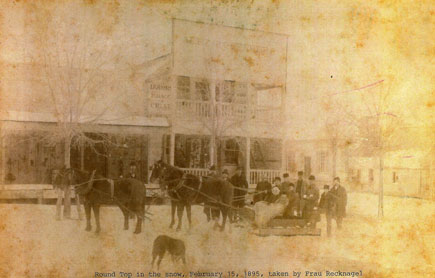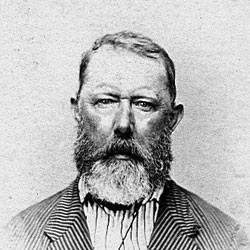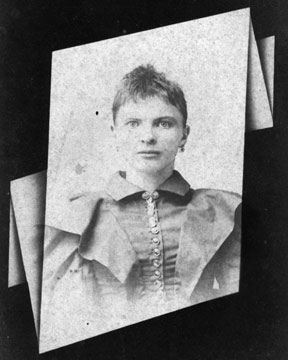The following is taken directly from the Handbook of Texas Online:
RECKNAGEL, FRIEDERIKE CAROLINE ELISE MICHAELIS (1860-1956). Friederike (Fritzchen) Recknagel, amateur photographer, was born on February 29, 1860, at the Nassau Farm, near Round Top, Texas, the first of two daughters and three sons born to Theodor Wilhelm and Hedwig (Groos) Michaelis, both of whom had immigrated to the United States from Germany. Her images of nineteenth-century Round Top, her family, and her friends document German-American family and community life on the Texas frontier. She was educated at home and in the Nassau Farm community. On June 1, 1886, she married Edward Recknagel, who had immigrated to Texas from Germany in 1878. The couple settled in Round Top, where Recknagel operated a pharmacy until about 1915. They had one daughter.

Friederike Recknagel photo of Sled in front of Alex Von Rosenberg Store in Round Top, 15 February 1895
|
It is not known when or how Friederike Recknagel learned to take photographs, although the age of her daughter in a number of images indicates that she was proficient in her craft by the mid-1890s. She used glass-plate negatives to make images of striking clarity, eschewing the romantically soft tonality then popular among many photographers. Described by her grandson as "strong-willed and independent minded," she recorded the buildings, events, and people of Round Top. Of particular interest to historians are her photographs of buildings now gone, such as the imposing 2-story stone home and boarding school built in 1865-66 for J. Adam Neuthard, then the pastor of the Bethlehem Lutheran Church. Another of her photographs reveals that a brick building that now houses offices and an antique store was the Round Top State Bank, which at that time sported a false front and a façade of punched tin. Mrs. Recknagel also recorded many domestic structures, ranging from a two-story Victorian-era wooden frame home to dogtrot log cabins. She photographed hogs being brought to market, the train passing through nearby Carmine, men hauling logs, and other events that shaped everyday life in the area. Other photographs capture more festive occasions, such as the signed and dated image of the 1895 Fourth of July parade in Round Top. Her portraits of a sharp-eyed dowager knitting a sock, a proud young man of Mexican descent beside his horse, and an impoverished family in front of their tiny home, attest to her skill in character studies. She also took several landscape shots, in which human figures are subsumed in a pattern of light and shade that verges on abstraction. Some sources have indicated that Friederike Recknagel wandered as far afield as Galveston to take pictures, although none of these images appear to have survived. Perhaps the most engaging group of photographs is a series of candid images in which she focused on her family and friends. Her photographs of her husband and daughter pelting each other with snowballs and trimming a Christmas tree offer a refreshing glimpse of family life, free of the stilted poses and self-conscious formality of most nineteenth-century photographs. Louise, the daughter, was a particularly charming model; in one photograph she cradles a log as if it were a doll while her father saws wood nearby, and in another she waded in a tub while a maidservant pumps water. Fritzchen also took a number of pictures of a neighbor, George August Edward Henkel, and his family. In one of the few pictures in which the photographer herself appears, examining her photographs with her husband and daughter, she presented herself in her various roles as a wife, mother, and photographer.
She continued to photograph until 1916-17, at which time she and her husband moved to Burton. Friederike Recknagel lived alone for a few years after Edward's death in 1937 but then joined her daughter in Houston, where she died on December 31, 1956. She was buried beside her husband in the Florida Chapel Cemetery in Round Top. Her photographs are in the private collections of Edward W. Ahlrich and Faith Bybee; copies of her work may be found in the collections of the Winedale Historical Center in Round Top and the University of Texas Institute of Texan Cultures in San Antonio. Her photographs were exhibited in Frontier America: The Far West, a 1975 exhibition organized by the Boston Museum of Fine Arts.
BIBLIOGRAPHY: Frontier America: The Far West (Boston Museum of Fine Arts, 1974). C. Jane Gover, The Positive Image: Women Photographers in Turn of the Century America (Albany: State University of New York Press, 1988). Brett Harvey Vuolo, "Pioneer Diaries: The Untold Story of the West," Ms., May 1975.
Kendall Curlee
See Footprints of Fayette article, The Recknagels of Round Top
 Gustav Froelich was a photographer at Round Top from about 1872 until 1912. Many of his photographs do not bear his name, but a few are stamped "G. Froelich."
Gustav Froelich was a photographer at Round Top from about 1872 until 1912. Many of his photographs do not bear his name, but a few are stamped "G. Froelich."
From Footprints of Fayette:
Gustav Froelich, Early Round Top Photographer
by Rox Ann Johnson
Gustav Froelich was a nineteenth century photographer who might be better remembered today if he had put his stamp on more of his work. Though he had a studio on the square in Round Top for the better part of forty years, relatively few photos have been identified as Froelich's.
Born into a prominent, though not very prosperous, family of ten children in the town of Ragnit in East Prussia on July 12, 1841, his father was Dr. Christoph Froelich and his mother was Eleanore von Rosenberg. The parents both died in 1846, setting the stage for three of their children to eventually emigrate. Gustav, who was only five, and his brother Adolph, who was seven years older, were taken in and given an education by their uncle, Johann Reinhold Froelich, who lived on the Collaten estate near Memel. Their youngest sister, Libussa, was adopted by another uncle, Peter Carl von Rosenberg, and lived nearby on his Eckitten Estate. The Froelich children were doubly related to the von Rosenbergs, as Peter Carl von Rosenberg was their mother's brother and his first wife was Dr. Froelich's sister.
Just three years later, in 1849, political problems made it necessary for Peter Carl von Rosenberg to quickly sell his estate and emigrate. His adopted niece, Libussa, was among the family members who left with him. In Texas, he bought land in Fayette County that had been part of the Nassau plantation near Round Top.
The von Rosenbergs encouraged their relatives to join them in Texas and when the older brother, Adolph Froelich, turned twenty-one in 1855, he also emigrated. Within two years, Adolph married another young German immigrant, Minna Doerr, and he became a merchant in Round Top.
In 1860, Gustav joined his relatives in the United States. However, shortly after his arrival in Texas, the state seceded and became part of the Confederacy. With few business opportunities available to him, Gustav Froelich and his two cousins, Alex and Walter von Rosenberg, enlisted in the Confederate Army under the command of Edmund Creuzbaur in October 1861. They were members of Creuzbaur's Battery, 5th Texas Artillery, most famous for the part it played in the Battle of Calcasieu Pass in 1864. For much of the Civil War this battery guarded the Texas coastline, from Brownsville to the Sabine Pass, though Froelich spent a fair amount of time on detached service.
In order to escape conscription into the Confederate Army in1862, Gustav's brother, Adolph Froelich, had sold his two lots in Block 18 of Round Top to his wife and left her and their two children there, while he traveled to Matamoros, Mexico to sit out the war. He became a Public Weigher of Cotton at Matamoras, but died of unknown causes there in 1864.
After the war, Gustav returned to Round Top and in 1867 he married his widowed sister-in-law, Minna Doerr Froelich. Five more children were born to them, though the first two died while still young.
It is believed that Gustav clerked for his cousin, Carl Johann von Rosenberg, until setting up a photography studio on Round Top's square. We know that he was taking pictures professionally by at least 1872 and that he practiced in that profession for most of the next forty years. He also served as mayor of Round Top from 1897 to 1901.
Unfortunately, most of his printed work does not bear his name. Many members of the von Rosenberg family came to their cousin for their portraits and some of these are recognizable by an elongated oval photograph inside a dark brown surround. Sometimes his oval photos and cardboard backing are deeply embossed and all of his early portraits are quite small and grainy. Several 1870s photos of his children show a particular fringed one-armed chair used as a prop. To identify others as his work, we must rely on clues from other props and backgrounds used in the few photos he stamped with "G. Froelich, Photographer, Round Top, Tex."
As photographic methods and equipment improved, the images in Froelich's photographs became sharper, but even the later ones do not match the crispness of Fredericke Recknagel's images. It is suggested that his photography business had slowed considerably by the early 1900s, when cousins turned to Recknagel for their portraits. In 1908 he began drawing his Confederate pension.
Minna Froelich passed away in 1914 and Gustav moved to Industry in neighboring Austin County where his daughter, Minnie Boelsche, now had a family. His son, Gustav Adolph Froelich, who had been a teacher at Round Top also moved to Industry.
Just a few years later, Gustav suffered a paralyzing stroke and, though he eventually was able to move about, he was essentially housebound. According to his obituary, his passion for books and periodicals brought comfort in his last years. He died at the advanced age of eighty years on May 18, 1922, after having broken his hip six months earlier. He lies in the Florida Chapel Cemetery near Round Top alongside his wife. He is gone, but his photographic images continue to give us clues to the past.
Sources:
1870 - 1920 U. S. Federal Census
Boethel, Paul C. The Big Guns of Fayette. Austin, TX: Von Boeckmann-Jones Co., 1965
Confederate Pension Application for G. Froelich, comptroller's file no. 13803
Fayette County Property Tax Records, various years
Fayette County Marriage Index
Froelich, Reinhold. Die Familie Froelich. Originally published in 1912. The Froelich Family, edition translated by Edward C. Breitenkamp, published in 1986.
La Grange Journal, June 1, 1922, page 5.
Lotto, Frank. Fayette County, Her History and Her People. Schulenburg, TX: Sticker Steam Press, 1902.
Haynes, David. Catching Shadows, A Directory of 19th Century Texas Photographers. Austin, TX: Texas State Historical Association, 1993.
Thornton, Cynthia A. The Times of Round Top. Bloomington, IN: Author House, 2013.
Von Rosenberg family research shared by Jon Todd Koenig and Neale Rabensburg
Photo courtesy of Neale Rabensburg
 |
|
|
This is possibly Clara Surman Heinsohn or her friend or relative
Contributed by Tommy Heinsohn and Rox Ann Johnson |
|
|

 Gustav Froelich was a photographer at Round Top from about 1872 until 1912. Many of his photographs do not bear his name, but a few are stamped "G. Froelich."
Gustav Froelich was a photographer at Round Top from about 1872 until 1912. Many of his photographs do not bear his name, but a few are stamped "G. Froelich."

